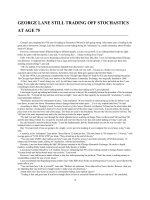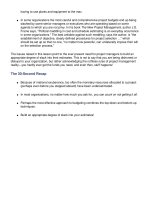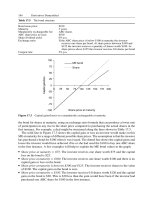Study guide for come into my trading room phần 6 docx
Bạn đang xem bản rút gọn của tài liệu. Xem và tải ngay bản đầy đủ của tài liệu tại đây (76.56 KB, 21 trang )
THREE
BASIC CHARTING
Answer 19
C. 4 and 5. Give yourself four points for choosing this answer, or two
points if you answered B (one correct out of two).
Prices are not a mirror image of values and can swing considerably
above and below value. Undecided traders who have the money and
watch the market influence it by their presence, putting pressure on
buyers and sellers to act faster.
Answer 20
1. C
2. A
3. B
4. D
Give yourself a point for each correct answer.
Nonprofessional traders are more likely to form their opinions in
the evening and place orders before going to work in the morning.
Professionals are more likely to dominate the market near closing time.
The high tick of every bar shows the limit of bullish power and the low-
est tick the limit of bearish power during that bar.
97
Answer 21
1. C, D
2. B, C
3. A
4. E
5. B
6. D
Give yourself a point for each correct answer (half a point if you got one
out of two). Add two points if you got the bonus question right, or a
point for getting it partly right.
Uptrendlines connect bottoms of rallies (line A), and downtrendlines
connect tops of declines (line B). Zones that served as support on the
way down become resistance on the way up, and vice versa (line C).
The behavior of prices at the tops sometimes mirrors that at the nearby
bottoms—a false upside breakout B was followed by a false downward
breakout D. Notice that Figure 3.1 is the chart of the Mexico Index—
technical analysis knows no borders.
At the right edge, neutral to bullish. Prices are rallying from a false
downside breakout, a bullish pattern. The rally is seven days old and
approaching a downtrendline, where prices are likely to run into stiff
resistance—potentially bearish. If prices break through, the next upside
target will be at the level of the early July peak.
Answer 22
1. D
2. A
3. B, C, E
4. F
98 ANSWERS AND RATING SCALES
Give yourself a point for each correct answer (half a point if you missed
a tail). Add two points if you got the bonus question right, or a point for
getting it partly right.
Downtrendlines (A) connect successively lower tops of rallies, and
uptrendlines (D) track rising bottoms. A break of a trendline often sig-
nals the end of a trend. Tails (B, C, and E) show what levels prices have
tested and rejected. Prices recoil from kangaroo tails. Channel lines (F)
can be drawn parallel to trendlines, framing the limits of bullishness
and bearishness.
At the right edge—toppy, time to take profits on long positions. The
stock is overbought, hitting its upper channel line—short-term bearish.
Wait for a pullback into the lower half of the channel before going long.
Answer 23
1. C-D, G-H
2. A, I, J
3. E
4. F
5. A-B, J-K
Give yourself a point for each correct answer (half a point if you got one
but not the other occurrence). Add two points if you got the bonus ques-
tion right, or a point for getting it partly right.
Price levels that serve as support on the way down become resist-
ance on the way up, which is especially well illustrated by line C-D.
Volume spikes A, I, and J indicate that a move is nearing an end. A
decline may stop immediately, as it did in area I, or continue to slide,
as it did in areas A and J, creating bullish divergences A-B and J-K.
Areas E and F are among several examples on this chart in which
volume rises during downswings and shrinks on upswings, which is
typical bear market behavior.
BASIC CHARTING 99
At the right edge—bullish in the short run, bearish for the longer
term. Merck is in a major downtrend, having fallen from above 95 to
near 60 in the eight months covered by this chart. Prices are inching
higher toward a heavy overhead resistance G-H, while volume is
shrinking, showing that bulls are weak and prices are likely to recoil
once they reach their overhead resistance.
Rating Yourself
Below 21 Poor. Chart reading is basic literacy for market analysts.
Indicators are important, but first you need to get a handle on the
basics. Please return to the recommended reading materials, study
them, and retake this test a few days later, before proceeding to the
rest of the Study Guide.
21–25 Fairly good. You understand and can use the key concepts of
charting. Still, it would pay to return to the recommended materials,
review them, fill in the gaps, and retake the test before proceeding to
more advanced computerized analysis.
26–29 Excellent. You can read the charts like an open book. Time to
move on and test your knowledge of modern computerized techni-
cal analysis.
Required Reading
Elder, Alexander. Come into My Trading Room (New York: John Wiley &
Sons, 2002). See “Basic Charting” in Chapter 5 (pages 64–80).
Additional Reading
Edwards, Robert D., and John Magee. Technical Analysis of Stock
Trends (1948) (New York: New York Institute of Finance, 1992).
Elder, Alexander. Trading for a Living (New York: John Wiley & Sons, 1993).
See “Classical Chart Analysis” (pages 69–114).
Schabacker, Richard W. Technical Analysis and Stock Market Profits (1932)
(London: Pearson Professional Limited, 1997).
100 ANSWERS AND RATING SCALES
FOUR
INDICATORS—
FIVE BULLETS TO A CLIP
Answer 24
1. B
2. C
3. D
4. A
Give yourself a point for each correct answer.
Both packages need to be fed fresh data and both can display charts
and indicators, but that’s where their paths diverge. Toolboxes help ana-
lyze the data but leave trading decisions to you. Black boxes claim to
liberate you from the onerous task of thinking, as they issue trading
commands. Neither guarantees a profit, but at least with a toolbox, if
you lose money, you can learn from your mistake instead of scapegoat-
ing the software.
Answer 25
1. A
2. B
3. B
4. A
5. B
101
Give yourself a point for each correct answer.
There are many more oscillators than trend-following indicators.
When you trade, it is important to choose a few indicators from each
group and combine them in order to balance their messages.
Answer 26
1. B
2. A
3. B
4. B
5. A
Give yourself a point for each correct answer.
The idea is to choose your favorite timeframe and then begin by ana-
lyzing the next higher one before returning to your favorite. Longer-term
charts help identify bigger trends and make strategic decisions. Two
timeframes are enough—you certainly never need more than three—
making a weekly chart superfluous for day-traders. Rallies are bigger than
declines in bull markets, and this applies to their duration as well as to
their extent.
Answer 27
1. D
2. A
3. B
4. E
5. C
Give yourself a point for each correct answer.
102 ANSWERS AND RATING SCALES
The slope of an MA shows whether bulls or bears are in control. The
shorter an MA, the more “whippy” it gets. Position traders should aver-
age closing prices, but day-traders can average high, low, and close.
Exponential moving averages, unlike simple ones, are not distorted by
dropping off old data. A moving average shows the average consensus
of value, and buying near the MA means buying value.
Answer 28
1. I
2. A, L
3. E, G, H, J
4. D, F, K
5. M
6. B
7. B-C
Give yourself a point for each correct answer (half a point if you missed
one of several occurrences). Add two points if you got the bonus ques-
tion right, or a point for getting it partly right.
Upturns and downturns of a moving average identify trend changes;
these are the most important messages of an MA. Buying at a rising
EMA (exponential moving average) means buying value, whereas chas-
ing rallies leads to greater fool theory trades—overpaying and hoping
that a greater fool will pay even more down the road. The letter L iden-
tifies a downtrend. Shorting in area M means shorting value, expecting
to cover below value. The kangaroo tail B serves as the first low of a
double bottom; prices try to grind down into that area but fail, and a
strong rally ensues.
At the right edge—bearish. The trend is down, identified by the EMA,
which is pushing lower. The shorting signal M is still in effect. Keep a stop
above the previous week’s high because if prices rise above it they will
complete a minor double bottom, including a false downside breakout,
and the EMA will turn up.
INDICATORS—FIVE BULLETS TO A CLIP 103
Answer 29
1. E
2. A
3. C
4. D
5. B
Give yourself a point for each correct answer.
The upper channel line reflects the normal limits of market optimism,
the lower line the normal limits of market pessimism. In uptrends, the
envelope hugs rally peaks, while lows may not reach the lower channel
line; in downtrends, the lows touch an envelope, while the highs may
not reach it. The longer the timeframe, the wider the envelope; the
weekly envelope is about twice as wide as the daily in the same market.
A well-drawn envelope contains about 95% of recent market data, while
Bollinger bands expand and contract with market volatility.
Answer 30
1. C, E, F
2. D, G
3. A, H, I, K
4. B, J
Give yourself a point for each correct answer (half a point if you missed
one of several occurrences). Add two points if you got the bonus ques-
tion right, or a point for getting it partly right.
The time to buy is when the trend is up, identified by a rising mov-
ing average. Buying near the rising EMA is a value trade. When prices
hit the upper channel line, they show that optimism is rampant, the
market is overbought, and it is a good time to sell and take profits.
Reverse the procedure in downtrends; when the EMA is down, short
104 ANSWERS AND RATING SCALES
near its level and cover when pessimism is overdone, with prices hitting
the lower channel line.
At the right edge—bearish to neutral. The trend is down, prices have
already touched their EMA, and are headed lower. If, within the next
few days, there is a rally above 75, touching the EMA, you may get a
chance to sell short and then look to cover near the lower channel line.
If not, stand aside and continue to monitor the stock. The downtrend is
getting a little long in the tooth, and you should be alert to the flatten-
ing of the EMA; when it turns up, it will give a strong buy signal.
Answer 31
1. B (27%)
2. C (14%)
3. D (−25%—loss)
4. A (39%)
Give yourself a point for each correct answer.
Measure the height of a channel from the upper to the lower chan-
nel line. If you take 30% of that distance or more out of a trade, it is an
A trade; 20% or better earns you a B; 10% or better a C; and anything
lower, including a loss, a D. A trade is not complete until you have rated
your performance on this scale.
Answer 32
1. D
2. E
3. A
4. C
5. B
Give yourself a point for each correct answer.
INDICATORS—FIVE BULLETS TO A CLIP 105
MACD-lines is the primary indicator, and MACD-Histogram is derived
from it, tracking the distance between the two lines. Divergences between
peaks and bottoms of MACD-Histogram and prices are among the
strongest signals in technical analysis.
Answer 33
1. F
2. E
3. A-B
4. C-D
5. B
Give yourself a point for each correct answer. Add two points if you got
the bonus question right, or a point for getting it partly right.
Prices fall to a new low A, rally, and then fall to a lower low B, where
MACD-Histogram traces a more shallow bottom. Notice a slight rally
above the centerline between the two lows, “breaking the back of the
bear.” This strong bullish message is reinforced by a tail in point B.
Prices rally to a new high C, pause, and then rise even higher at D, while
MACD-Histogram completes a bearish divergence, rising to a very
shallow top, with a fall below the centerline between the two peaks.
Divergences are the strongest signals of MACD-Histogram, but there are
many more ordinary rises and declines, confirming market moves, not
only in areas E and F, but all over the chart.
At the right edge—bearish. MACD-Histogram is declining, confirm-
ing the downtrend of the EMA.
Answer 34
Phrase 4 does not apply. Give yourself three points for choosing the
correct answer.
106 ANSWERS AND RATING SCALES
Force Index measures price change between yesterday and today, but
it uses the absolute value of today’s volume rather than any change.
Answer 35
1. B, C
2. E, F, G
3. A
4. A, D, E, H
Give yourself a point for each correct answer (half a point if you missed
one of several occurrences). Add two points if you got the bonus ques-
tion right, or a point for getting it partly right.
Force Index gives buy signals when it declines below zero during
uptrends. You can find other points, in addition to B and C, where the EMA
rises while Force Index becomes negative, giving a buy signal. Force Index
gives sell signals when it rises above zero during downtrends. It identified
shorting opportunities at points E, F, and G, as well as many others. The
bullish divergence in area A develops when prices try to break down to a
new low, while the lows of Force Index become more and more shallow.
The spikes of Force Index identify exhaustion moves. This chart captures a
bearish period in the life of GX, but even so, most downward spikes of
Force index lead to substantial rallies or a pause in the downtrend.
At the right edge of the chart—neutral to bearish. The trend is down,
the latest spike has interrupted the decline, and prices are likely to hold
flat for a while. Watch out for either a breaking of the low H or a bullish
divergence to tell you whether the decline is likely to continue or reverse.
Answer 36
1. D
2. E
3. A
4. C
5. B
INDICATORS—FIVE BULLETS TO A CLIP 107
Give yourself a point for choosing the correct answer.
While the slope of an EMA identifies the trend, Bull Power and Bear
Power show how far the high and the low of each bar deviate from the
EMA. The time to buy in an uptrend is when a bar straddles the EMA,
but Bear Power begins to slip. The time to sell short in a downtrend is
when a bar straddles the EMA, but Bull Power begins to weaken.
Answer 37
1. A, C, D
2. F
3. B
4. B-E
5. E
Give yourself a point for each correct answer (half a point if you missed
one of several occurrences). Add two points if you got the bonus ques-
tion right, or a point for getting it partly right.
When the trend, identified by the slope of the EMA, is up and Bear
Power becomes negative but then ticks upward, it gives a buy signal.
This occurred three times during the uptrend of April–May. The oppo-
site, a shorting signal, occurs when the EMA signals a downtrend, and
Bull Power rises to or above zero, but then ticks downward. Whenever
Bull Power traces a new record peak for the past several months, it iden-
tifies great power of bulls and calls for higher prices ahead. Shortly
before entering area E, Bull Power became negative for the first time
since the beginning of the rally; when it rose to a new, lower peak and
then ticked down, it completed a bearish divergence. That strong sell
signal was confirmed by a kangaroo tail; important technical signals
often confirm one another.
At the right edge of the chart—bearish. The trend, identified by the
EMA, is down, and Bear Power is becoming deeper, while bulls are
underwater. Wait for a rally to the EMA to add to shorts.
108 ANSWERS AND RATING SCALES
Answer 38
Choice 4. Give yourself four points if you identified it.
Stochastic is an oscillator whose overbought and oversold readings
identify the best areas for buying and selling. Its divergences, as well as
those of most other indicators, give the strongest buy and sell signals.
One thing that Stochastic, as well as other oscillators, does not do is
identify trends; that is the job of trend-following indicators, such as
moving averages and MACD.
Answer 39
1. C, E, I, J, L
2. A, B, D, F, G, H, K
3. I-J
4. A-B, G-H
Give yourself a point for each correct answer (half a point if you missed
one of several occurrences). Add two points if you got the bonus ques-
tion right, or a point for getting it partly right.
Stochastic identifies overbought conditions and gives sell signals
when it reaches its upper reference line and turns down. It identifies
oversold conditions and gives buy signals when it reaches its lower ref-
erence line and turns up. Divergences between indicators and prices
provide some of the strongest signals in technical analysis. The stock ral-
lies to a higher high at B than at A, but Stochastic turns down from a
lower peak, providing an extra powerful sell signal. This pattern recurs
in area G-H, just as the stock is knocking its head against the resistance
area above 47.50. When different technical patterns flash the same sig-
nals, they confirm one another, reinforcing each other’s message.
At the right edge of the chart—neutral. The stock has just broken
down to a new low, while Stochastic is not confirming. Wait for the
indicator to tick up with your finger on the trigger. If it ticks up from a
higher level than in area M, it will complete a bullish divergence and
give a strong buy signal. On the other hand, if Stochastic does not turn
INDICATORS—FIVE BULLETS TO A CLIP 109
up and create a bullish divergence, it will confirm the strength of the
downtrend—stay short.
Rating Yourself
Below 58 Poor. Computerized indicators are powerful tools, offering
important insights into crowd behavior. You need to understand them
better before moving on to trading. Please return to the recom-
mended reading materials, study them, and retake this test a few days
later, before proceeding to the rest of the Study Guide.
58–70 Fairly good. You have grasped the key concepts of computerized
technical analysis. Now decide whether your current level of under-
standing is sufficient for your style of trading or whether you should
return to the recommended materials, review them, and retake the
test before proceeding.
71–86 Excellent. You have a handle on computerized technical analy-
sis. Now that you know how to read the markets, it is time to move
on and test your knowledge of trading.
Required Reading
Elder, Alexander. Come into My Trading Room (New York: John Wiley
& Sons, 2002). See “Indicators—Five Bullets to a Clip” in Chapter 5
(pages 80–117).
Additional Reading
Elder, Alexander. Trading for a Living (New York: John Wiley & Sons,
1993). See “Computerized Technical Analysis” (pages 115–166).
LeBeau, Charles, and David W. Lucas. Technical Traders Guide to Computer
Analysis of the Futures Market (New York: McGraw-Hill, 1991).
Murphy, John J. Technical Analysis of the Financial Markets (Englewood
Cliffs, NJ: Prentice-Hall, 1999).
110 ANSWERS AND RATING SCALES
FIVE
TRADING
Answer 40
D. 1, 2, 3, and 4. Give yourself four points for choosing the correct
answer (two points if you answered C or E, partly correct).
A good trading system pulls out a few key factors from the huge mass
of market information. Market-driving factors keep slowly changing,
which is why system parameters must be tweaked with the passage of
time. Discretionary traders with a good feel for the markets focus their
attention on different factors at different times. All beginners are pre-
occupied with entries, but you get paid for exiting trades. An automatic
system, especially if purchased from a vendor, is a gambler’s dream, but
trading requires persistent work.
Answer 41
C. 1, 2, and 3. Give yourself four points for choosing the correct
answer.
To be worth trading, a system must provide a positive mathematical
expectation of generating more money than it loses over a period of time.
The only way to find out is to test the system yourself. Computerized test-
ing may be more objective, but manual testing more closely replicates the
experience of trading the markets, with all its psychological stresses. You
have to manually test your system to find whether it fits your tempera-
ment as well as your wallet. Most parameters of a trading system can be
111
tweaked, except for a few inviolate rules, including money management
rules. Even if a system seems to do better after dropping those rules, you
should not expose your account to unlimited risk.
Answer 42
C. 1, 2, and 3. Give yourself four points for choosing the correct answer.
The main value of paper trading is it allows you to test your discipline
and ability to do homework day after day, although most people simply
escape into it after losing money. If done right, paper trading takes just
as much time as the real thing. The results of paper trading almost
always look better than real trading, because there is no emotional pres-
sure from risking money.
Answer 43
1. C
2. D
3. A
4. D
5. B
Give yourself a point for each correct answer.
You cannot argue with the direction or the numerical value of an
indicator, which is why their signals are more objective than chart pat-
terns. The three indicator groups almost always give contradictory sig-
nals. One of the main challenges in technical analysis is to reconcile
those conflicts and profit from them.
112 ANSWERS AND RATING SCALES
Answer 44
D. 1, 2, 3, and 4. Give yourself four points for choosing the correct
answer.
The contradictions between signals in different timeframes present a
challenge, as well as an opportunity. We can filter them against one
another, leaving only the best signals. Long-term as well as short-term
charts are defined by their relationships to the intermediate timeframe,
using the Rule of Five. Short-term charts allow you to get closer to the
markets, but it is much more important to begin your analysis by mak-
ing a strategic decision on long-term charts.
Answer 45
Phrase 3 is correct. Give yourself four points for choosing the right
answer.
One of the key rules of the Triple Screen is to make your decisions in
several timeframes, moving down from the longest to the shortest. If you
work with weekly, daily, and intraday charts, then make your strategic
decision, either bullish or bearish, on the weekly chart, then tactical on
the dailies, and find entry and exit points using intraday charts.
Answer 46
Choice 4 is not acceptable. Give yourself three points for choosing the
right answer.
Buying an upside breakout puts you in the direction of the trend,
whereas buying pullbacks provides less expensive entries. These are
all acceptable methods, but it is seldom a good idea to put in orders
without even knowing what price you will have to pay at the opening
tomorrow.
TRADING 113
Answer 47
D. 1, 2, 3, and 4. Give yourself four points for choosing the right answer.
There are many methods for exiting trades. A longer-term trader will
watch the EMA, the resistance, or the channel, whereas the shorter-term
trader will focus on the channel or the spikes in Force Index. Use the
method that appeals to you, but do not make your decisions “on the
gut.” If you sell on the gut today, you will be tempted to buy on the gut
tomorrow, and that’s where the real trouble will start.
Rating Yourself
Below 24 Poor. You need to give yourself a little more time to learn
about trading before putting money on the line. Testing systems and
indicators, while combining different timeframes, is a key concept of
successful trading. Please return to the recommended reading mate-
rials, study them, and retake this test a few days later before pro-
ceeding to the rest of the Study Guide.
24–28 Fairly good. You understand the key concepts of trading. Still, it
would make sense to read up on the questions that you have missed.
This topic is too important to leave out a few blanks.
29–32 Excellent. You understand the key trading ideas. If you are inter-
ested in day-trading, please proceed to the next chapter; otherwise,
skip it and go directly to Advanced Concepts, Chapter 7.
Required Reading
Elder, Alexander. Come into My Trading Room (New York: John Wiley &
Sons, 2002). See “System Testing” and “Triple Screen Update” in Chap-
ter 6 (pages 121–134).
Additional Reading
Elder, Alexander. Trading for a Living (New York: John Wiley & Sons, 1993).
See “Triple Screen Trading System” (pages 235–243).
Kaufman, Perry J. Smarter Trading (New York: McGraw-Hill, 1995).
Schwager, Jack D. Technical Analysis of the Futures Markets (New York:
John Wiley & Sons, 1995).
114 ANSWERS AND RATING SCALES
115
SIX
DAY-TRADING
Answer 48
D. 1, 2, 3, and 4. Give yourself four points for choosing the right answer.
In day-trading, profits are smaller and expenses are higher. There are
long periods of “dead time,” but when a signal comes, you must recog-
nize it instantly and trade without pausing to ruminate. Losses are gen-
erally smaller than in position trading because losing trades are closed
out no later than at the end of the day.
Answer 49
C. 1 and 4. Give yourself four points for choosing the right answer.
Day-trading demands a much higher degree of concentration than
position trading because it does not leave you time to think. Impulsivity
is deadly because you have no time to correct your mistakes. Day-
trading is an expensive proposition that generates high commissions and
leads to purchases of software, data, and other tools, that are the main
reasons why brokers and vendors love it. To succeed, you must face
your impulsivity and work to reduce it. A written trading plan is a use-
ful step in that direction.
Answer 50
2. Penny stocks are unsuitable for day-trading. Give yourself four points
for choosing the right answer.
The two essential criteria for choosing day-trading stocks are liquid-
ity and volatility. You can find stocks that keep making big moves on
high volume among the most actives or the most popular stocks. Penny
stocks may be promising for investors, but are not good for day-traders
because of their narrow intraday ranges and low liquidity.
Answer 51
1. D
2. E
3. C
4. B
5. A
Give yourself a point for each correct answer.
The intraday volume curve is normally U-shaped—highest during the
first and last half-hours of trading. Early in the session outsiders crowd
into the market, and by the end of the day the pros dominate the action.
A wide opening range may define the high and the low of the day, but
prices are likely to break out of a narrow opening range.
Answer 52
1. B
2. A
3. D, E, F, G
4. C
5. C-H
116 ANSWERS AND RATING SCALES
Give yourself a point for each correct answer (half a point if you missed
one of several occurrences). Add two points if you got the bonus ques-
tion right, or a point for getting it partly right.
When a downward gap first appears, it is hard to tell whether it is a
continuation of the downtrend or an exhaustion move prior to an
upside reversal. The downside breakout from the opening range con-
firms the downtrend and gives the first good shorting signal of the day.
The deepening bottoms of MACD-Histogram show that the bears are
growing stronger and lead one to expect lower prices ahead. Rallies to
the EMA create shorting opportunities throughout the day. During the
last hour of trading prices dip to a new low, while MACD-Histogram
traces a higher bottom. This bullish divergence gives a buy signal—time
to take profits on shorts.
At the right edge of the chart—bearish. The trend is down, and prices
closed near the lows; expect a lower opening tomorrow. The beauty of
day-trading is that there is no overnight risk. We can wait for the open-
ing, monitor the opening range, and then trade the breakout.
Answer 53
C. 1, 2, and 3. Give yourself four points for choosing the right answer.
The best time to make strategic decisions is before the opening—if
the stock does this, I will trade this way, and so on. Then, as you review
your stocks throughout the day, you are ready to act fast whenever your
conditions are met. There is no harm listening to tips, as long as you put
them through the same screens as your regular stocks; perhaps they
should be added to the regular list. Trading in a room full of people is
much more likely to lead to emotional decisions. Successful traders
almost always sit at the edge of the trading room, isolating themselves
from the masses.
DAY-TRADING 117









